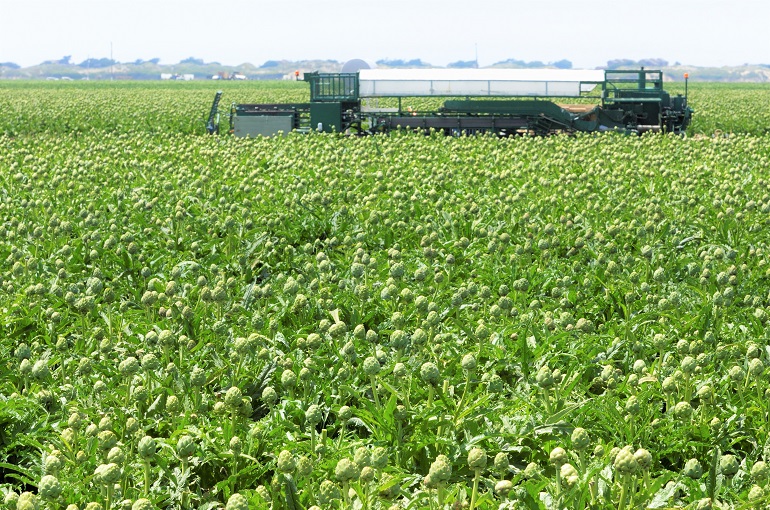Artichoke Farming: Harvest, Yield, Storage, and Post-harvest handling

This post is also available in:
This post is also available in:
![]() Español (Spanish)
Español (Spanish) ![]() Français (French)
Français (French) ![]() Deutsch (German)
Deutsch (German) ![]() العربية (Arabic)
العربية (Arabic) ![]() Türkçe (Turkish)
Türkçe (Turkish) ![]() Ελληνικά (Greek)
Ελληνικά (Greek) ![]() Português (Portuguese (Brazil))
Português (Portuguese (Brazil))
What is the average yield per acre and hectare for artichoke farming?
A healthy artichoke produces 5-10 or more flowerheads (flower stalks), with 3-5 buds each, depending on the variety, and the environmental and growing conditions. Some producers apply thinning to the plants to remove some flower heads and force the plant to transfer its power to fewer but bigger artichokes. Other farmers use growth regulators to achieve the same thing and accelerate maturation (consult your agronomist).
A good yield after years of practice of a well-established mature crop could be 8-20 tons per hectare, 50,000-180,000 flower heads (artichokes), or around 1360 cartons per hectare (550 cartons per acre). More specifically, during the second year of production, an average yield is 4,000-5,000 kg per hectare (3,567-4,460 lb/acre). During the third and fourth years of cultivation, we have the largest yields of 7,000-20,000 kg per hectare (6,245-17,843 lb/acre). Normally from the 5th and 6th year onwards, yields may decrease again, providing 6,000-9,000 kg per hectare (5,355-8,030 lb/acre). Keep in mind that these are just some average yields reported, and the actual yield of your field may differ significantly, depending on the means of production, environmental conditions, the experience of the farmer, etc.
When and how to harvest artichokes
Artichokes’ harvesting time varies depending on the environmental conditions, the soil type, the cultivated variety, and the growing techniques. Artichokes can be harvested when the buds have reached the acceptable commercial size of their variety. At that moment, the lower bracts begin to separate, and the head is still soft and compact. When reaching this stage, the buds must be collected within a short period, or they will mature, the bracts will open, become hard (woody), bitter, and the head quality will drop significantly. Not all heads mature at the same time. In fact, the same plant may have artichokes in different maturing stages on it. In regions with milder winter, the perennial crop may produce year-round 30-40 harvests, with a pick of the production during spring. However, artichokes cultivated as annuals have a shorter, more concentrated harvesting period. During the period of peak production, the farmer can harvest by hand, using scissors or knives, every 5-10 days. They cut the heads together with 7.5-20 cm (3-7,9 in) of stem. In fact, harvesting operations account for as much as 40% of the total production costs in Globe Artichoke. The edible heads are harvested in most cases by hand, machine harvesting being hindered by an extended harvest maturity. Workers pass many times through the field in order to complete the job. The pickers move through the rows cutting the mature heads and placing them in sacks carried along the field.
Storing and classification of artichokes
Usually, the artichokes are sold soon after harvest, but for temporary storage, the farmer can apply a precooling treatment (4-5 °C or 40 °F) and store them at 0 °C (32-33 °F) and 90-100% relative humidity for 2-4 weeks. Artichokes are usually packaged in cartons and boxes classified by size. The most popular size categories in the market are the largest ones (when 18-24 or 36 buds in a box), with the harvested buds to have a diameter between 4 and 4.5 in (10-11.5 cm).
Post harvesting handling of the plants
Producers cut the upper part of the plant, keeping only 1-2 leaves (offshoots) to prepare it for the dormancy period and encourage the development of side shoots. The crop residues also have commercial value, as they are sold as livestock feed and for biofuel production. Dormancy is the right period to collect root crowns for future cultivation. If the dormancy period lasts over two months, many producers “wake them up” by irrigating them. In areas with frosts, it is advised to apply heavy mulching to the plants. Some producers prefer to rotate the crop (with broad beans and artichokes) to control diseases and prevent soil from depleting.
References
- https://www.agronomy.it/index.php/agro/article/view/1252/1039#content/citation_reference_97
- https://horticulture.oregonstate.edu/oregon–vegetables/artichoke–globe
- https://digitalcommons.usu.edu/cgi/viewcontent.cgi?article=1239&context=extension_curall
- https://www.nda.agric.za/docs/Brochures/Artichoke2011.pdf
- https://www.marketnews.usda.gov/mnp/fv–help-20
- http://www.omafra.gov.on.ca/CropOp/en/spec_veg/other_spec_veg/arti.html
- https://www.researchgate.net/
How to Grow Artichokes at Home
How to Grow Artichokes for Profit – Professional Artichoke Farming
Climate and Soil Requirements for Artichoke Farming
Soil Preparation and Planting in Artichoke Farming
Artichoke Water Requirements and Irrigation Systems
Artichoke Fertilization Requirements
Artichoke Farming: Harvest, Yield, Storage, and Post-harvest handling








































































